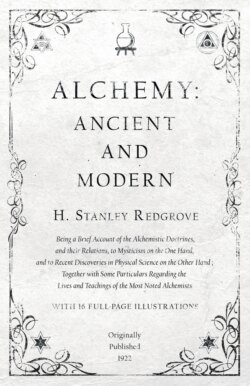Читать книгу Alchemy: Ancient and Modern - Being a Brief Account of the Alchemistic Doctrines, and their Relations, to Mysticism on the One Hand, and to Recent Discoveries in Physical Science on the Other Hand - H. Stanley Redgrove - Страница 18
На сайте Литреса книга снята с продажи.
The Law of Analogy.
Оглавление§ 10. With the theories of physical Alchemy we shall deal at length in the following chapter, but enough has been said to indicate the analogy existing, according to the alchemistic view, between the problem of the perfection of the metals, i.e., the transmutation of the “base” metals into gold, and the perfection or transfiguration of spiritual man; and it might also be added, between these problems and that of the perfection of man considered physiologically. To the alchemistic philosopher these three problems were one: the same problem on different planes of being; and the solution was likewise one. He who held the key to one problem held the key to all three, provided he understood the analogy between matter and spirit. The point is not, be it noted, whether these problems are in reality one and the same; the main doctrine of analogy, which is, indeed, an essential element in all true mystical philosophy, will, we suppose, meet with general consent; but it will be contended (and rightly, we think) that the analogies drawn by the alchemists are fantastic and by no means always correct, though possibly there may be more truth in them than appears at first sight. The point is not that these analogies are correct, but that they were regarded as such by all true alchemists, Says the author of The Sophie Hydrolith: “. . . the practice of this Art enables us to understand, not merely the marvels of Nature, but the nature of God Himself, in all its unspeakable glory. It shadows forth, in a wonderful manner . . . all the articles of the Christian faith, and the reason why man must pass through much tribulation and anguish, and fall a prey to death, before he can rise again to a new life.”10 A considerable portion of this curious alchemistic work is taken up in expounding the analogy believed to exist between the Philosopher’s Stone and “the Stone which the builders rejected,” Christ Jesus; and the writer concludes: “Thus . . . I have briefly and simply set forth to you the perfect analogy which exists between our earthly and chemical and the true and heavenly Stone, Jesus Christ, whereby we may attain unto certain beatitude and perfection, not only in earthly but also in eternal life.”11 And likewise says Peter Bonus: “I am firmly persuaded that any unbeliever who got truly to know this Art, would straightway confess the truth of our Blessed Religion, and believe in the Trinity and in our Lord Jesus Christ.”12
